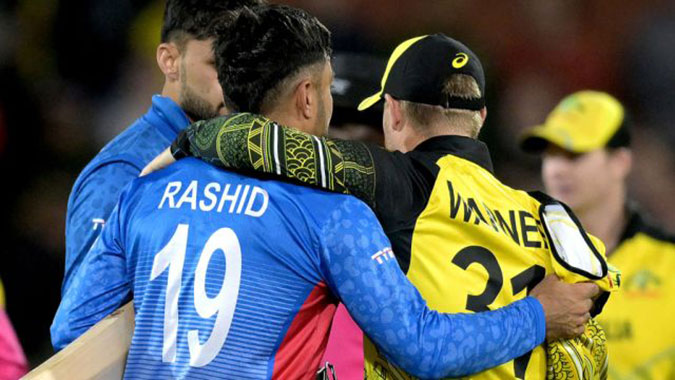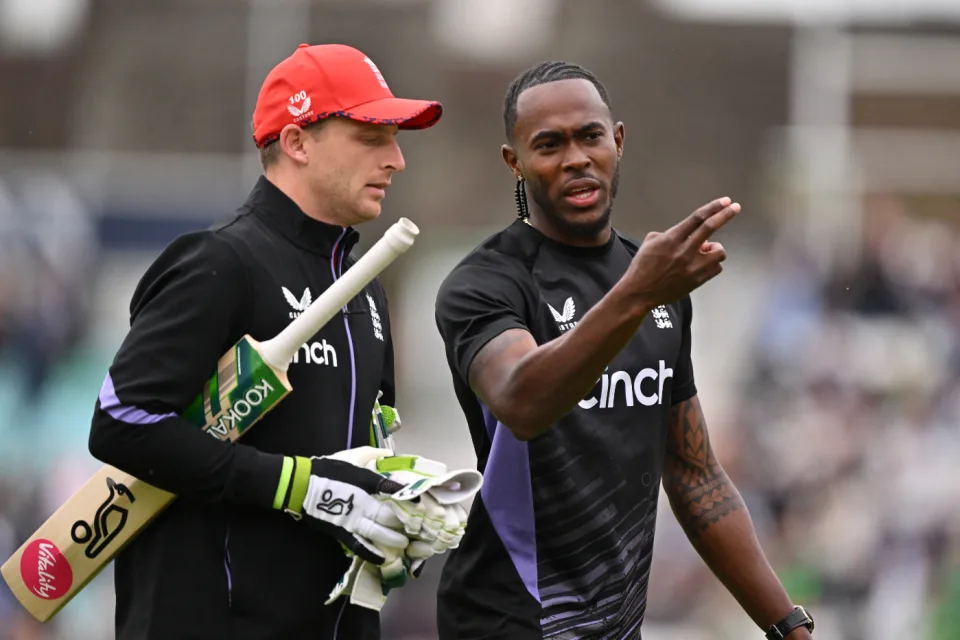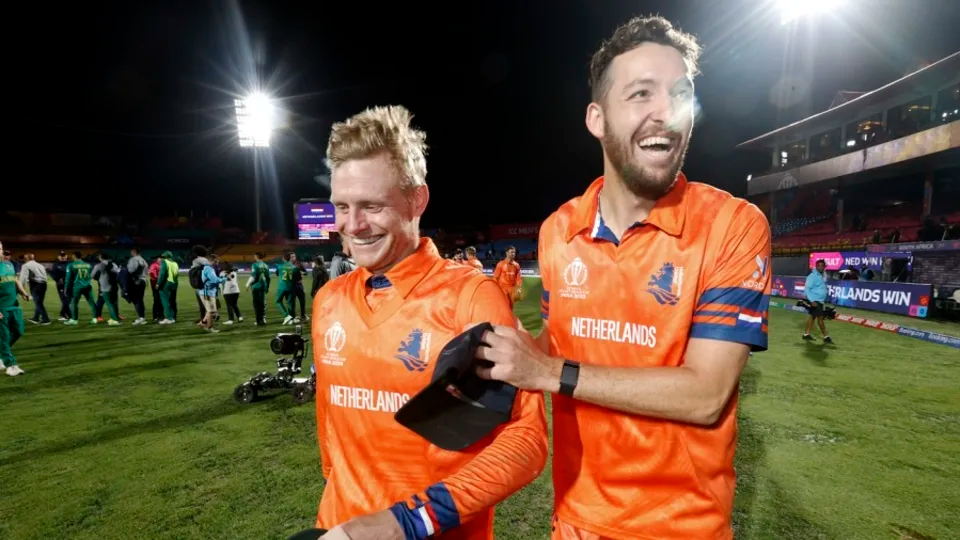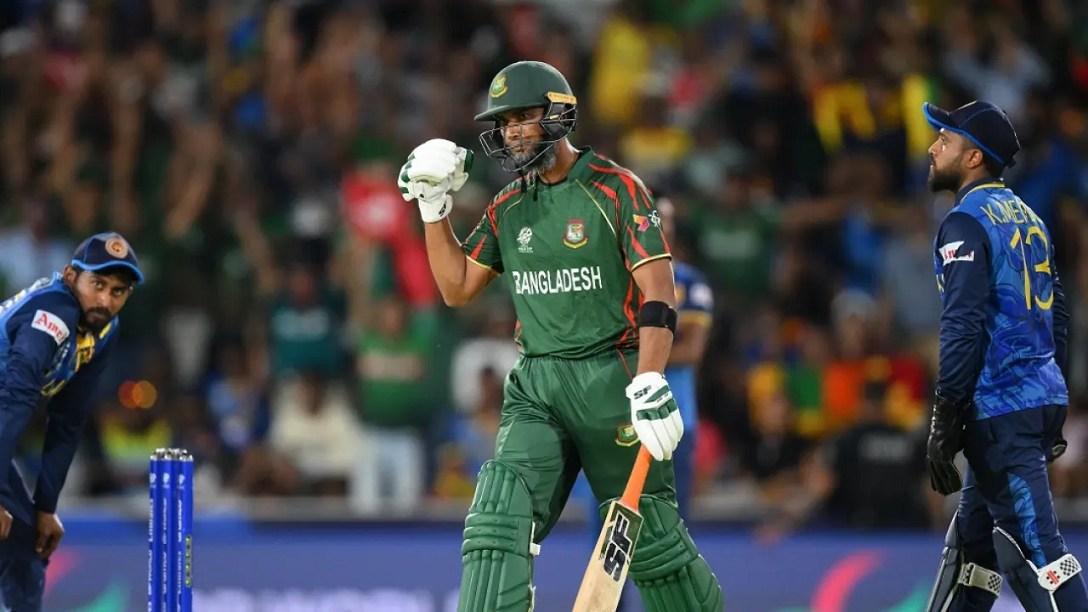Sports
Australia relying on Sri Lanka after sneaking past Afghanistan

Glenn Maxwell did his best to keep Australia’s semi-final hopes alive with an assertive, unbeaten half-century, but the hosts’ chances of reaching the knockouts are out of their hands after a classy performance from Afghanistan, who gave them an almighty scare chiefly through Rashid Khan at Adelaide Oval. Defending champions Australia needed to contain their opposition to 106 runs or fewer to overhaul England’s net run rate even before England play Sri Lanka in their final group game on Saturday.
The hosts managed 168 for 8 from their 20 overs on the back of Maxwell’s knock after Naveen-ul-Haq and Fazalhaq Farooqi took five wickets between them to restrict their opponents to a total that looked competitive for the match but not so much to ensure their progression . New Zealand have sealed a semifinal berth (Australia needed to beat Afghanistan by 185 runs to beat their NRR) and it was the Black Caps’ 89-run victory in their opening match that proved so costly to Australia’s title defence. Now, only an upset by Sri Lanka over England will see Australia through; if England win, they will join New Zealand in the next phase. Chasing 169, Gulbadin Naib shared a 59-run stand with Ibrahim Zadran for the third wicket but with a flurry of four wickets in nine balls – two to Adam Zampa in his last over – Australia wrested back control of the match. Rashid frightened the home fans, while thrilling his own supporters at the ground known as his ‘second home’ when he plundered an unbeaten 48 off 23 balls at the death, but Australia managed to hold on and win by four runs.
There was plenty of buzz about this match, given what was at stake for Australia, and the chatter grew ever louder when Mitchell Starc was left out of their line-up. Aaron Finch and Tim David were replaced by Cameron Green and Steve Smith less controversially after both failed to pull up adequately from hamstring injuries. But Starc making way for Kane Richardson left commentators and spectators confounded. Starc had been largely used through the middle overs at this tournament, but his damaging yorker and proven ability to blast out opposing sides were seen as a potential missed opportunity on this occasion. As it happened, Richardson struck with his third ball of the tournament, removing Rahmanullah Gurbaz for a sprightly 30 off 17 balls.
Gurbaz had made an eventful start, smoking the sixth ball of the Afghanistan innings into the second tier over deep square leg off Josh Hazlewood, surviving a sharp run-out chance as bowler Pat Cummins side-footed the ball onto the stumps and apparently hurting his shoulder as the two collided inadvertently in the process. Gurbaz was deemed fit to bat on and made a valuable contribution. Mitchell Marsh found himself at the crease in the third over after Cameron Green fell for just 3, slashing Farooqi to Gulbadin at slip. David Warner had helped himself to four fours by this time, and was running for everything. But it didn’t work. Marsh had seen Warner and Smith depart in the same Naveen over before he was put down at point by Najibullah Zadran off Gulbadin with 19 to his name. Marsh went on to reach 45 off 30, slog-sweeping Mujeeb Ur Rahman over the square-leg boundary and sending Gulbadin’s leg-cutter into the stands straight down the ground. But he fell top-edging Mujeeb straight above his head for Gurbaz to hold the catch behind the stumps.
Cue Maxwell’s excellent knock as he powered his way to 54 not out from just 32 deliveries. He peppered the boundary with some impressive shots through the covers and twice cleared the fence over midwicket to keep Australia’s tempo and heads up. Naveen’s three wickets were pivotal in putting a lid on an Australian side needing as big a total as possible to help their troubled title ambitions. Then, Gurbaz’s bright start and Gulbadin’s determined innings before he was run out by an excellent Maxwell throw from midwicket had Afghanistan within touching distance the magical 106- run total that would have helped Australia’s NRR comparison with England considerably. When Afghanistan went from 98 for 2 to 99 for 5 and 103 for 6, they were still shy of the mark. Then in came Rashid, a star of the Adelaide Strikers’ side in the Big Bash, to compile his career-best T20I score. He proceeded to smash four sixes, including back-to-back maximums off Richardson into the stands over deep midwicket and
 long-off and another off Marcus Stoinis beyond deep square leg that left his side needing 12 off the last two balls of the match. He managed two into the gap between long-on and long-off followed by a four that left Afghanistan just short of their target but the crowd not short of excitement. Brief scores: Australia 168 for 8 (Glrnn Maxwell 54*, Mitchelle Marsh 45, Naveen-ul-Haq 3-21) beat Afghanistan 164 for 7 (Rashid Khan 48*, Gulbadin Naid 39, Adam Zampa 2-22) by four runs
long-off and another off Marcus Stoinis beyond deep square leg that left his side needing 12 off the last two balls of the match. He managed two into the gap between long-on and long-off followed by a four that left Afghanistan just short of their target but the crowd not short of excitement. Brief scores: Australia 168 for 8 (Glrnn Maxwell 54*, Mitchelle Marsh 45, Naveen-ul-Haq 3-21) beat Afghanistan 164 for 7 (Rashid Khan 48*, Gulbadin Naid 39, Adam Zampa 2-22) by four runs
(Cricinfo)
Sports
England face Australia in the battle of champions

The first truly heavyweight clash of this expanded T20 World Cup format comes freighted with both history and subplots. A rematch of the 2010 World T20 final at Kensington Oval, the match pits Jos Buttler’s defending champions – who are aiming to become the first team to retain the trophy – against the Australian winning machine, victors at the 2021 edition and current world title-holders in Test and ODI cricket. And that’s before you throw in the Ashes for afters.
Already there is added pressure on England, after the rain in Bridgetown led to a share of the points in their opener against Scotland (and that having conceded 90 runs from 10 overs without taking a wicket in a tepid bowling display). Lose to their oldest rivals and it will leave their Super 8 prospects open to being waylaid by the perils of net run-rate calculations, or worse.
The Scotland match was the third abandonment in five suffered by England, after a rain-affected home series against Pakistan, which has clearly hampered their readiness for this campaign after almost six months without playing T20 together. It does not take much for a side to click in this format – and England looked in decent shape when they did get on the field against Pakistan – but Buttler will be anxious for things to go their way on Saturday, if only to avoid further questions referencing the team’s disastrous ODI World Cup defence last year.
Australia, under the laidback leadership of Mitchell Marsh would love nothing more than to add to the English sense of jeopardy – having helped bundle them out of the tournament in India on the way to taking the crown. Their head to head record is less impressive in T20 however, with England having won six of the last seven completed encounters, as well as that 2010 final.
Despite a wobble with the bat, Australia avoided mishap against Oman earlier in the week, the experience of David Warner and Marcus Stoinis shining through in difficult batting conditions. Surfaces in the Caribbean – not to mention those games staged in the USA – have already had teams scratching their heads; rather than the “slug-fest” England had prepared for, following a high-scoring tour of the Caribbean in December, it looks as if boxing smart may be the way to go.
Speaking of Warner, this could be the last time he faces up against England in national colours – and another match-winning contribution would likely reduce the chances of them meeting again in the knockouts. On the other side of the card is Jofra Archer, fresh from an emotional maiden outing at Kensington Oval and ready to take on Australia for the first time in any format since 2020. Can Mark Wood fire up England’s campaign, as he did during last summer’s Ashes? Will Pat Cummins be back to harass the old enemy once again? Seconds out, it’s almost time to rumble.
Cummins is set to return after being rested for the Oman game, which saw Mitchell Starc leave the field with cramp. Starc is understood to be fine and could keep his place – which would likely see Nathan Ellis miss out. Marsh is still not fit to bowl, with Australia likely to continue with the allrounder combination of Stoinis and Maxwell to give them cover.
Australia (probable XI): David Warner, Travis Head, Mitchell Marsh (capt), Glenn Maxwell, Marcus Stoinis, Josh Inglis (wk), Tim David, Pat Cummins, Nathan Ellis/Mitchell Starc, Adam Zampa, Josh Hazlewood
The one change England may consider is Reece Topley coming in for Wood, with the expectation that there will be some rotation among the seamers through the course of the tournament.
England (probable XI): Phil Salt, Jos Buttler (capt & wk), Will Jacks, Jonny Bairstow, Harry Brook, Liam Livingstone, Moeen Ali, Chris Jordan, Jofra Archer, Adil Rashid, Reece Topley/Mark Wood
[Cricinfo]
Sports
South Africa up against their bogey team in batter-unfriendly New York

Once is coincidence, twice is a clue, and three times is proof.
To paraphrase Agatha Christie, that is the narrative around South Africa’s meeting with Netherlands at this T20 World Cup.
The Dutch beat South Africa at the 2022 tournament and ended their semi-final hopes in a match where South Africa appeared to be sleep walking, and then beat them again at the 2023 ODI World Cup, where they exposed South Africa’s vulnerability in the chase. If they to do the treble, not only will Netherlands take the lead in Group D, but they will offer conclusive evidence of the threat they pose to Full Members, especially South Africa.
Of course, it will take some doing after South Africa’s opening performance against Sri Lanka, where they reduced their opposition to their lowest T20I total and chased it down in fairly straightforward fashion thanks to the most stable middle-order of their white-ball era. In Aiden Markram, Tristan Stubbs, Heinrich Klaasen and David Miller, South Africa have bankers and big-hitters and, for this match, they also have the advantage of experience. They’ve already played at Eisenhower Park, and have first-hand knowledge that run-scoring doesn’t come easily;Klassen said they are prepared to use their “cricket brains” and play “smarter cricket”.
But the conditions could be good news for Netherlands, who are not naturally a line-up of big hitters and build their innings on a foundation of turning ones into twos. In other words, they tend to take a slightly more conservative approach to batting, which may work well here, but they’ll be wary of the uneven bounce of the surface and will have to come up with plans to counterattack especially against South Africa’s seamers. Their own bowlers were exemplary in Dallas and will look to build on that performance against a line-up that will likely be more proactive than Nepal’s, but who they have managed to keep quiet not once, but twice in the past. Third time’s the charm, they say.
Anrich Nortje’s stunning return to form against Sri Lanka means South Africa may not have to tinker with the bowling combination, and Gerald Coetzee and Tabraiz Shamsi may have to wait their turns to get a game. The batting line-up should be unchanged, with no space for Ryan Rickelton yet.
South Africa: Quinton de Kock (wk), Reeza Hendricks, Aiden Markam, Tristan Stubbs, Heinrich Klaasen (wk), David Miller, Marco Jansen, Keshav Maharaj, Kagiso Rabada, Ottneil Baartman, Anrich Nortje
Conditions in New York may tempt Netherlands to include an extra seamer and they have Kyle Klein in their squad. But it could come at the expense of a shortened batting line-up and they may not want to risk that.
Netherlands: Michael Levitt, Max O’Dowd, Vikramjit Singh, Sybrand Engelbrecht, Scott Edwards (capt, wk), Bas de Leede, Teja Nidamanuru, Logan van Beek, Tim Pringle, Paul van Meekeren, Vivian Kingma
[Cricinfo]
Latest News
Mustafizur, Rishad, Hridoy dazzle in Bangladesh’s tight two-wicket win over Sri Lanka

Nuwan Thushara’s last over brought Sri Lanka screaming back into the match,as he first bowled Rishad Hossain, and then nailed Taskin Ahmed in front of the stumps with a pinpoint swinging yorker. This left Bangladesh eight wickets down, with 12 runs still to get.
However, the experienced Mahmudullah was at the crease for Bangladesh, and despite some further nervy moments, pushed Bangladesh across the line off the last ball of the 19th over.
But this was a match chiefly decided by Bangladesh’s own outstanding bowling. Mustafizur Rahman was the best among them, using shorter lengths and his cutters efficiently, to claim figures of 3 for 17. Rishad Hossain’s three-for through the middle overs also kept Sri Lanka quiet.
Mustafizur was instrumental in Sri Lanka’s downward spiral through the middle overs, which culminated in a crash-and-burn end. Ultimately, their inability to find boundaries, or even rotate strike against good Bangladesh bowling resulted in their downfall. A score of 125 for 9 always seemed poor on a decent pitch, even if their bowlers made a match of it in the end.
Brief scores:
Bangladesh 125 for 8 in 19 overs (Towhid Hridoy 40, Litton Das 36; Dhanajaya de Silva 1-11, Nuwan Thushara 4-18, Wanidu Hasaranga 2-32, Matheesha Pathirana 1-27) beat Sri Lanka124 for 9 in 20 overs (Pathum Nissanka 47, Dhananjaya de Silva 21; Tanzim Hasan Sakib 1-24, Taskin Ahmed 2-25, Mustafizur Rahman 3-17, Rishad Hossain 3-22) by two wickets
[Cricinfo]












